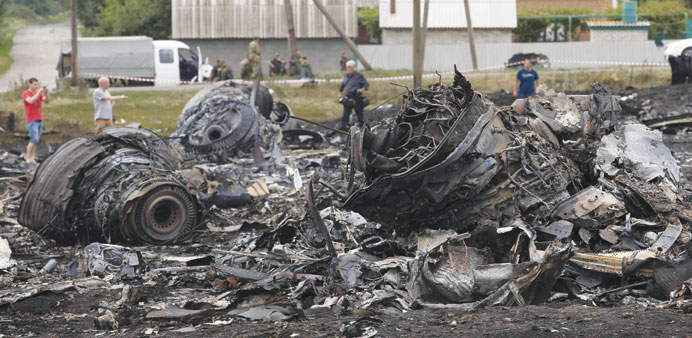By Updesh Kapur /Doha
As the political ramifications continue over the shooting down of flight MH17 and killing of all 298 people on board, the airline industry has been rallying behind the scenes to address key issues that have dogged it since the tragedy.
With safety and security foremost in an industry deemed the safest mode of transport, the aviation sector has been hit hard by the unfolding events surrounding the commercial airliner being blown out of the sky at 33,000ft over the Russian Ukrainian border.
Many questions remain unanswered in the current environment where the industry is demanding solutions as much as the travelling public seeking answers.
A Boeing 777 belonging to one of Asia’s finest, Malaysia Airlines, packed with holidaymakers and business travellers on a flight from Amsterdam to Kuala Lumpur, was shot down two weeks ago in an incident that sent shock waves across the travel spectrum.
And the political fall-out has been huge, for all to see. In particular, sanctions imposed on Russia, a powerhouse blamed for its backing of anti-Ukrainian rebels said to be responsible for bringing down the aircraft in a conflict zone.
“The tragic shooting down of MH17 was an attack on the whole air transport industry,” said Tony Tyler, director general and CEO of the International Air Transport Association (IATA).
“The world’s airlines are angry. Civil aircraft are instruments of peace. They should not be the target of weapons of war. That is enshrined in international law through the Chicago Convention.”
The vocal boss of the industry’s leading airline representative body was reacting after IATA hooked up with other key organisations to agree on setting up an urgent joint task force to review processes for flying over conflict zones.
IATA has joined forces with the International Civil Aviation Organisation (ICAO), Airports Council International (ACI) and the Civil Air Navigation Services Organisation (CANSO) to declare a commitment with support of industry partners – to immediately establish a senior level Task Force comprising state and industry experts to address civil aviation and national security issues arising from MH17.
The Task Force will look at how relevant information can be effectively collected and disseminated to improve overall safety in the air.
Crucial is the implementation of fail-safe channels for governments to readily provide essential threat information to civil aviation authorities and airlines which would greatly help in risk assessments of flying zones.
In the case of MH17, the severe risk of flying over Ukrainian airspace was evidently not made clear.
In addition, there are now calls for governments to implement, through appropriate international frameworks, measures that oversee the design, manufacture and deployment of modern anti-aircraft weaponry.
In the case of MH17, it was a surface-to-air missile that brought down the aircraft. Such technology poses a danger to civil aviation and what commercial airlines want curbing.
“There is no need for major surgery,” added Tyler, but he said the aviation sector “must identify and close some specific gaps in the system that, however infrequently, lead to unspeakable mistakes and tragedies.”
His reference was to the tragedy of MH17 and the mysterious disappearance of its Boeing 777 sister, M370, four months ago with 239 passengers and crew onboard.
“Every day about 100,000 flights take to the air and land safely,” added Tyler. The systems supporting global aviation have produced the safest mode of transportation known to humankind.”
But IATA reinforces the need for clear, accurate and timely information on risks as being vitally important for its airline members.
“We were told that flights traversing Ukraine’s territory at above 32,000 feet would not be in harm’s way.
“We now know how wrong that guidance was. It is essential that airlines receive clear guidance regarding threats to their passengers, crew and aircraft. Such information must be accessible in an authoritative, accurate, consistent, and unequivocal way,” said IATA’s top man, urging countries to be more accountable without making excuses.
A dilemma in accurate, consistent and authoritative information was faced post MH17 with the missile attack on Tel Aviv’s Ben Gurion Airport resulting in three separate agencies communicating three very different messages.
Israeli authorities declared the airport was safe; the US Federal Aviation Administration instructed its airlines not to fly to Ben Gurion; while the European Aviation Safety Agency recommended European airlines should not fly there.
Governments need to do better to handle such incidents with correct and authoritative information that travellers and the industry alike can have some comfort from.
Last week, demands for industry bodies to bring onboard new protocols in light of the threat of regional conflict were made in the strongest possible manner.
It is clear that IATA and ICAO, as well as peer bodies, are on the right flight path to get things done. But there has to be a real willingness by all key stakeholders, including governments to implement steps sooner rather than later to ensure the lessons learnt from the past few weeks are not repeated.
- Updesh Kapur is an aviation and travel expert. He can be followed on twitter @updeshkapur

The crash site of the Malaysian flight MH17 near the Ukraine-Russia border.
